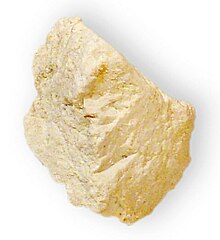| Halloysite | |
|---|---|
 | |
| General | |
| Category | Phyllosilicates Kaolinite-serpentine group |
| Formula (repeating unit) | Al2Si2O5(OH)4 |
| Strunz classification | 9.ED.10 |
| Crystal system | Monoclinic |
| Crystal class | Domatic (m) (same H-M symbol) |
| Space group | Cc |
| Unit cell | a = 5.14, b = 8.9, c = 7.214 [Å]; β = 99.7°; Z = 1 |
| Identification | |
| Color | White; grey, green, blue, yellow, red from included impurities. |
| Crystal habit | Spherical clusters, massive |
| Cleavage | Probable on {001} |
| Fracture | Conchoidal |
| Mohs scale hardness | 2–2.5 |
| Luster | Pearly, waxy, or dull |
| Diaphaneity | Semitransparent |
| Specific gravity | 2–2.65 |
| Optical properties | Biaxial |
| Refractive index | nα = 1.553–1.565 nβ = 1.559–1.569 nγ = 1.560–1.570 |
| Birefringence | δ = 0.007 |
| References | [1][2][3] |
Halloysite is an aluminosilicate clay mineral with the empirical formula Al2Si2O5(OH)4. Its main constituents are oxygen (55.78%), silicon (21.76%), aluminium (20.90%), and hydrogen (1.56%). It is a member of the kaolinite group. Halloysite typically forms by hydrothermal alteration of alumino-silicate minerals.[4] It can occur intermixed with dickite, kaolinite, montmorillonite and other clay minerals. X-ray diffraction studies are required for positive identification. It was first described in 1826, and subsequently named after, the Belgian geologist Omalius d'Halloy.
- ^ Anthony, John W.; Bideaux, Richard A.; Bladh, Kenneth W.; Nichols, Monte C., eds. (1995). "Halloysite" (PDF). Handbook of Mineralogy. Vol. II, 2003 Silica, Silicates. Chantilly, VA, US: Mineralogical Society of America. ISBN 978-0962209710.
- ^ "Halloysite: Halloysite mineral information and data". mindat.org.
- ^ Barthelmy, Dave. "Halloysite Mineral Data". webmineral.com.
- ^ Cite error: The named reference
Kerr_1952was invoked but never defined (see the help page).